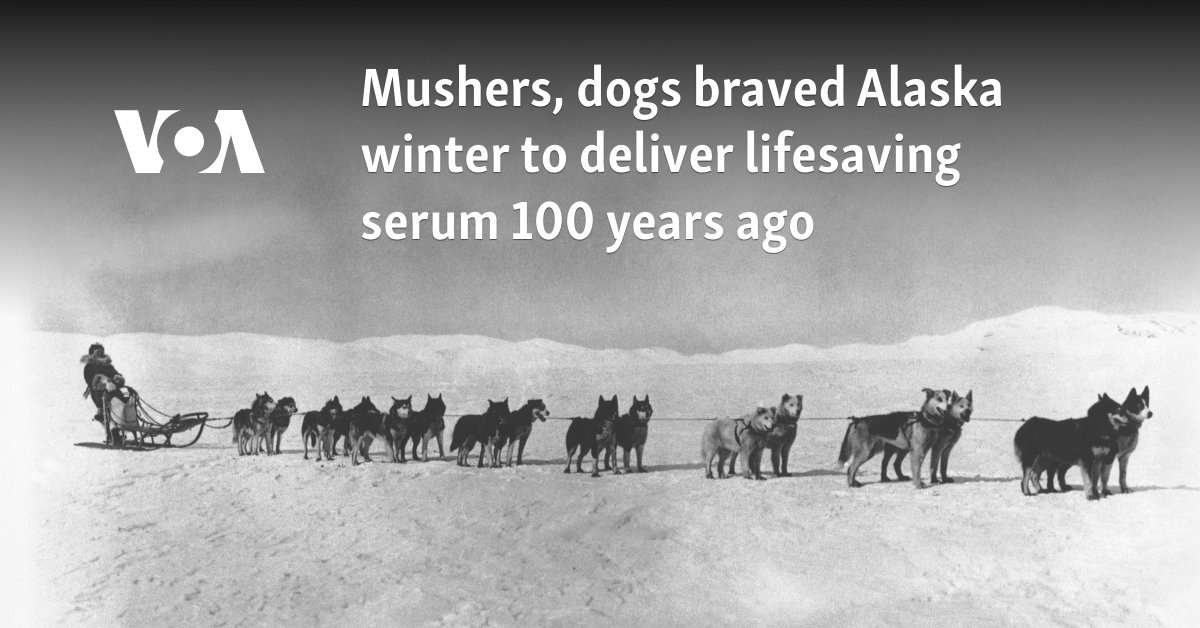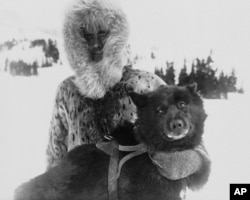Alaska Gold Rush Town of Nom faced a foggy winter. It was at a distance of hundreds of miles from anywhere, was cut off from a frozen sea and incredible icy storm, and for the way children were suffocated, from an infectious disease known as “Struggling Angel” under siege.
Now, after 100 years, Nom is recalling its servants-the sled dogs and Musher, who used to run for more than five days through hypothermia, frostbite, gayle-force winds and distribute life-wing serum and distribute the serum and from diphtheria Used to blind the whiteout to free the community.
In the events that celebrate the centenary of the 1925 “Mercy’s Great Race”, lectures, a dog-food drive and the final stage of the relay are re-evaluated, which are all conducted by the Nom Kennel Club.
Alaskans Samman ‘Veer Prayer’
“There is a lot of inflating around such ceremonies, but we want to remember the Musar and their dogs who have bees at the center of this brave effort and … … Spotlight the spotlight in, “Diana hacker said, Kennel Club Member and Alaska’s oldest newspaper co-owner, Nom Naget.
“Whatever people are doing, dropped it,” he said. “Thesis Musher prepared his teams and went away, even though it was a challenging situation on the real cold and mark.”
Other communities are marking the anniversary – including the Nenana village, where the relay, and Cleveland, Ohio, where the most famous contestants of the serum run, a Husky Mix Mix, is displayed and displayed in a museum.
Jonathan Hayes, a main resident who is working to preserve the genetic line of sled dogs run by the famous Musher Leonhard Sepla, is re -creating the journey. Hayes on Monday left Nenana with 16 seepla Siberian sled dogs, a registered descendant of Sepla’s team.
A race to save life
Diphtheria is an aerial disease that causes a thick, suffocating film behind the throat; This onca was a major cause of death for children. Antipoxine was used to treat, developed in 1890, and a vaccine in 1923; It’s now very rare in America
Western Alaska’s largest community Nom had about 1.400 residents a century ago. Its most recent supply ship had come into the previous decline, before the Bringing Sea settled without any dosage of the ship Antoxin. Local doctors, Curtis Welch, were old, but he was not worried. Hey did not see the case of diphtheria in 18 years, which he practiced in the region.
Within months, it changed. In a telegram, what argued with the US Public Health Service to send serum: “An epidemic of diphtheria is almost mandatory here.”
The first death was a 3 -year -old boy on January 20, 1925, after which the next day was a 7 -year -old gold girl. By the end of the month, there were more than 20 confirmed cases. The city was placed undercuantine.
West Coast Hospitals had an antoxin dose, but it would take time to carry them on a ship to a ship for Seattle, Washington, and again Sevard, Alaska, on the snow-free port in the south of Aincorn, Alaska. Meanwhile, for 30 people found sufficient in an anchrel at a hospital.
It was still to go to Nom. Airplanes with open-air cockpit were rejected as unsuitable for the weather. There were no roads or trains that reached Nom.
Instead, the authorities sent Nenana to the serum by rail in the interior Alaska, about 1.086 km (675 mi) from the nam via frozen Yukon River and Mail trails.
Thanks to Alaska’s new telegraph lines and the spread of radio, with the nation, as 20 Musher, many of them locked the serum with more than 150 dogs – in the relay in the relay. He struggled with deep snow, whiteouts so severely they could not see dogs in front of them, and sometimes a life-threatening temperature temple to mines 51 ° C (60 ° F) (60 ° F).
Antipoxin was covered with a padded quilt in glass vials. Not a single vial was broken.
A Norwegian settling Sippala, left to complete the supply near halfway from the nom and began the journey. Under the leadership of his dog Togo, his team traveled more than 320 km (250 mi) of the relay, including a trusted stretch in the frozen Norton Sound.
After about 5 1/2 days, Serum reached its destination on 2 February 1925. A banner in front-page headline in San francisco chronicle The dogs declared “Dogs victorious over the urgent storm in the fight of quarrels.”
Five deaths and 29 diseases were listed in the official record. It is likely that great was high; The Alaska native was not accurately tracked.
Balto profit fame
Seepla and Togo recalled Lelmelite going to their assistants, Gunnar Kasen, who took the dog team to the nome under the leadership of Balto. Balto was one of Sipppala’s dogs, but was used only for freight after being understood to be in a competitive team.
Balto was immortalized in films and with idols at Central Park, New York and as a tribute to all sled dogs in an ankorez. She found a bone -shaped key for the city of Los Angeles, where the legendary film actress Mary Pickford placed a wreath around her neck.
But he and several team members were sold and kept in squalid conditions at a dime museum at Los Angeles. After learning his plight, an Ohio businessman inspired an attempt to raise money to bring Cleveland. After dying in 1933, Balto was mounted and placed on a performance at the Cleveland Museum of Natural History.
Iditarod pays tribute to running
Today, the most famous Musling event in the world is the Iditrode Trail Sled Dog Race, which is not based on serum run, but on the Iditrid trail, a supply route from sequence to nom. Race spokesperson Shannon Nunnan said in an email that the organizers of Iditrode were marking the centenary of the serum run with a series of articles on their website and met a century ago by selling medals replicas. This year’s Editrode begins on 1 March.
“Serum Run performed the important role in the existence and communication of remote Alaska communities, while Iditrode developed at the celebration of that tradition and the leading spirit of Alaska,” said Nunnan.









Leave a Reply